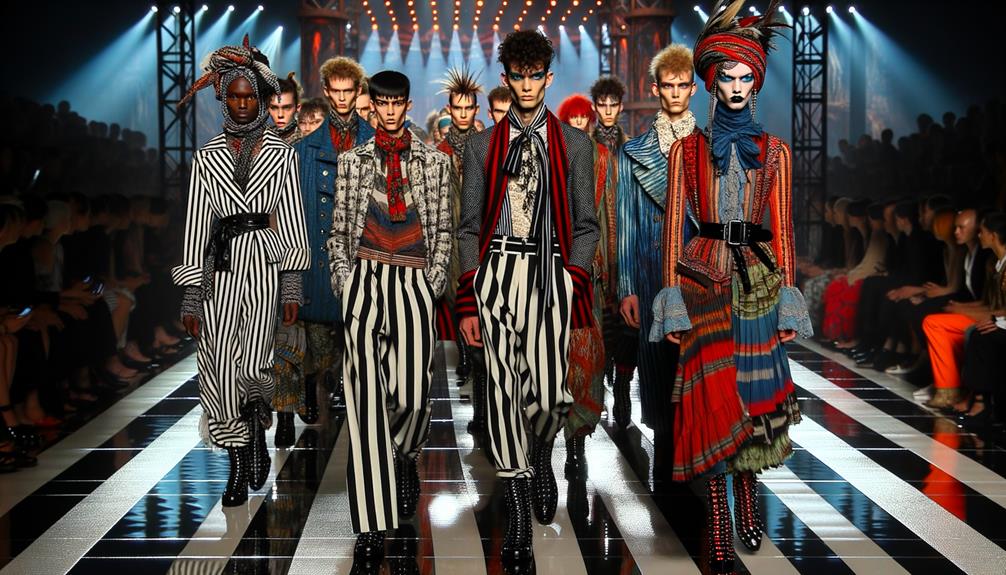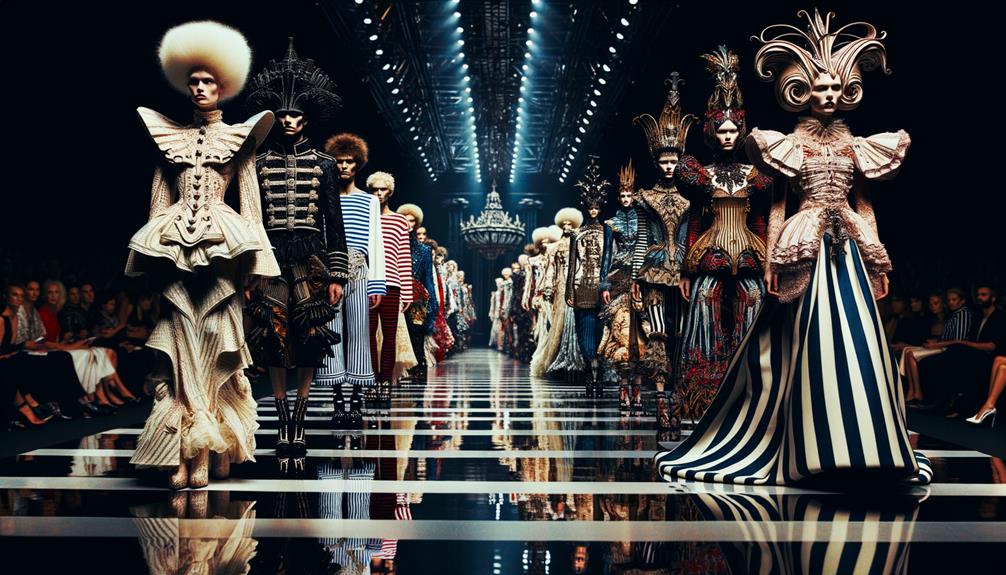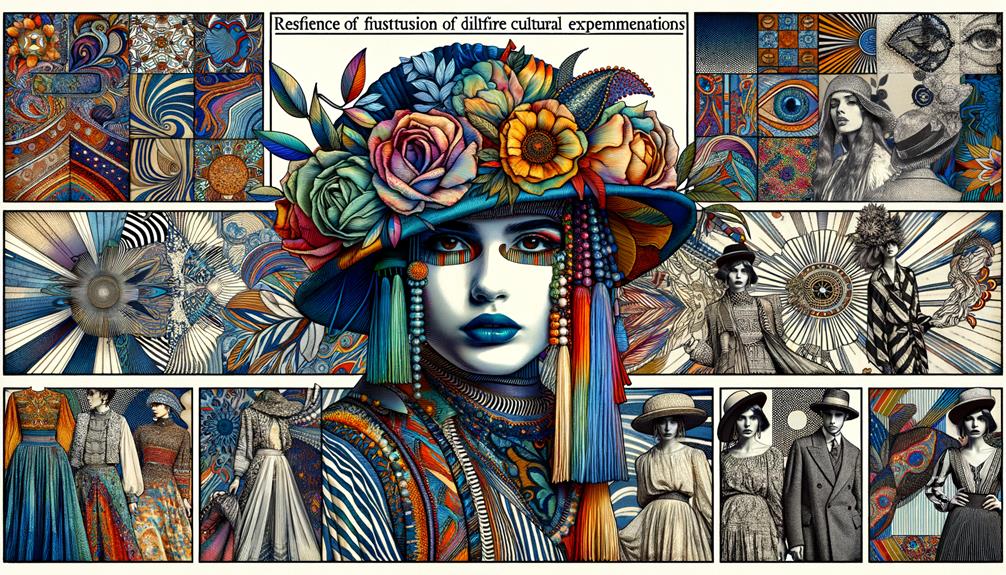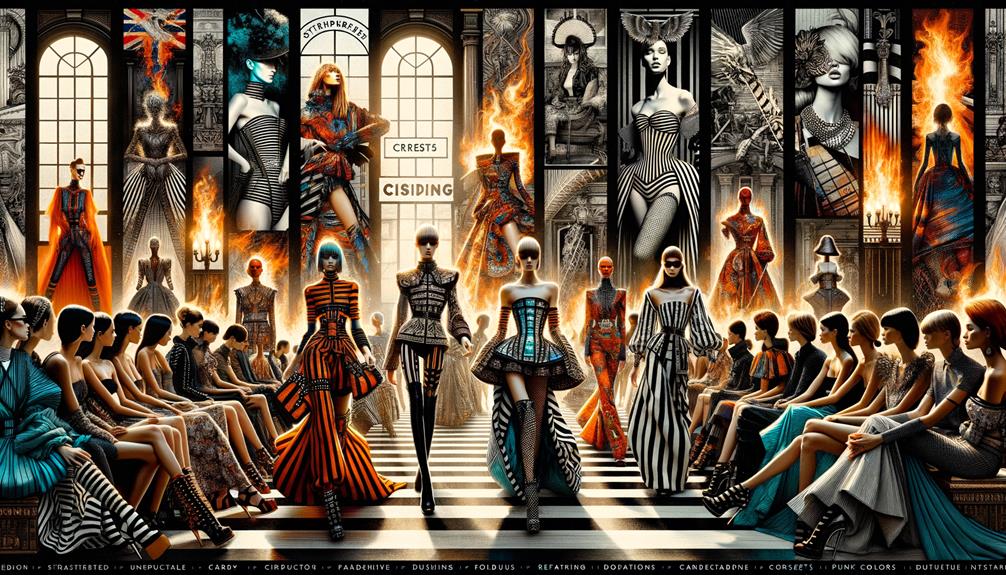Jean Paul Gaultier's journey is a vibrant tapestry of rebellion and elegance. Born in Arcueil in 1952, he ventured into fashion without formal training, leaving an indelible mark. His creations – men's skirts, cone bras – challenge norms and celebrate individuality. He finds beauty in the unusual and eclectic, drawing inspiration from French culture and beyond. Each runway show is a theatrical narrative told through fabric and form. His work transcends fashion, advocating for diversity and inclusivity. Gaultier's legacy continues to inspire, inviting us to see the world through his unconventional lens.
Early Life and Career
Born on April 24, 1952, in Arcueil, France, I embarked on my fashion journey without formal design training, driven by innate creativity and audacity. From the start, I felt a deep connection to the world of French fashion, where every stitch tells a story. My path crossed with legends like Pierre Cardin and Jean Patou, each encounter shaping my spirit and vision.
I didn't attend a fashion school; instead, I learned from the world around me, observing, absorbing, and transforming. My early work with these haute couture giants taught me to challenge conventions. They called me the 'enfant terrible' of fashion, a nickname I wore with pride. In 1982, I took a bold step, founding my eponymous fashion house. My designs weren't just clothes; they were statements of inclusivity and boldness.
Through every fabric and form, I sought to push boundaries and challenge norms. As a fashion designer, my mission was to craft a world where everyone felt seen and celebrated. My unconventional journey demonstrated the power of authenticity and relentless innovation.
Signature Style

In my designs, I merge rebellion and elegance, blending streetwear with haute couture to challenge traditional fashion norms. My signature style is more than just clothes; it's a bold statement of individuality and acceptance. I draw inspiration from French popular culture and futuristic visions, creating pieces that defy convention and celebrate what makes us unique.
My fashion is a space where gender blending meets audacity. I pioneered men's skirts and cone bras, breaking barriers and inviting society to rethink its perceptions. By using unconventional materials – like plastic trash bags for dresses – I turn the ordinary into the extraordinary, proving that beauty can emerge from unexpected places.
My runway isn't a parade of the typical; it's a celebration of diversity. Models are friends, staff, and eclectic individuals, each one a representation of the spectrum of human beauty. This diversity isn't just visual; it's philosophical, advocating for inclusivity in an industry often obsessed with uniformity.
Through my designs, I invite you to a world where fashion is an art form that celebrates our differences, encouraging a deeper embrace of individuality and acceptance.
Iconic Designs

Through my most iconic designs, I strive to craft a narrative that transcends mere fabric and thread, creating symbols that resonate deeply within the cultural zeitgeist.
Madonna's iconic corset with cone bra, which she wore during her Blond Ambition tour, became an emblem of audacious femininity. This design wasn't just provocative; it was a bold statement of empowerment. Similarly, the mermaid dress I crafted for Mylène Farmer exudes an ethereal allure, embodying fantasy and sensuality in every curve.
My fragrance, Le Male, extends this narrative into the olfactory world, merging traditional masculinity with a contemporary twist. Each catwalk show I orchestrate is a spectacle that challenges conventions and captivates fashion editors and audiences alike.
- Madonna's Blond Ambition Tour: The corset with cone bra
- Mylène Farmer's Mermaid Dress: A symbol of fantasy and sensuality
- Le Male Fragrance: Redefining masculinity through scent
- Catwalk Shows: Theatre and fashion blended into a seamless experience
As a creative director, I'm constantly pushing the boundaries of fashion, urging others to see beyond the seams. My designs invite you to explore a world where every stitch tells a story, every fabric whispers a secret, and every silhouette challenges the norm.
Cultural Impact

Amid the ever-changing landscape of fashion, my designs have woven a rich tapestry of diversity, inclusivity, and bold individuality, forever reshaping the industry's aesthetic. From the start, I aimed to challenge norms by featuring androgynous and transgender models on the runway, showcasing the beauty of the unconventional. Every fashion show was a vibrant statement, where the unusual became the celebrated norm. My collaboration with the Maison wasn't just about garments; it was a harmonious blend of film, dance, and celebrity, creating a cultural phenomenon.
In Paris, the fashion capital, my exhibitions stood out as catalysts for change. They whispered of a world where corsets could be worn as outerwear, and skirts found their place in men's wardrobes. These weren't mere provocations but assertions that fashion should embrace every aspect of human experience.
As a fashion designer, I saw the runway not just as a stage, but as a reflection of society's potential for inclusivity. With every stitch, I celebrated the beauty of diversity, advocating for a more accepting industry. My designs, unconventional as they may be, are love letters to individuality, forever transforming how we perceive fashion.
Legacy in Fashion

Reflecting on the transformative power of my designs, I see my legacy in fashion as a testament to the enduring allure of originality and rebellion. I've always pushed boundaries with innovative designs like the cone bra corset and men's skirts. These creations were more than just garments; they were statements, challenges to conventional perceptions of gender and style.
My journey as the 'enfant terrible' of French fashion was marked by a fearless blending of streetwear with haute couture. I found beauty in the unexpected, drawing inspiration from the eclectic, the marginalized, and the bold. Collaborating with iconic figures like Madonna and crafting over 500 costumes showcased my vision on global stages.
- Cone Bra Corset: A symbol of bold femininity and empowerment.
- Men's Skirts: Challenging gender norms and redefining masculinity.
- $50 Million in Sales by 1985: Confirmation of commercial success and influence.
- Retirement in 2020: Marking the end of a celebrated runway career.
In my retirement, I look back on a career that never ceased to innovate. My legacy lives on in the daring hearts of those who continue to challenge the status quo in fashion, echoing the spirit of Jean Paul Gaultier.
Frequently Asked Questions
What Designer Is Similar to Jean Paul Gaultier?
I find Vivienne Westwood to be a kindred spirit to Gaultier. Her bold, rebellious designs echo his ethos, pushing boundaries and celebrating individuality. Both designers seamlessly blend history and streetwear into a unique tapestry of innovation, making them pioneers in their field.
What Type of Designer Is Jean Paul Gaultier?
Jean Paul Gaultier is a fashion rebel, a force that shatters conventional norms and creates beauty from unexpected places. I see him as a visionary who masterfully blends streetwear with haute couture, celebrating individuality and diversity in the process.
Who Is Similar to Jean Paul Gaultier?
When considering designers similar to Jean Paul Gaultier, I think of Vivienne Westwood, Rick Owens, Rei Kawakubo, Alexander McQueen, and Iris van Herpen. They all share a flair for crafting garments that blur the lines between fashion and art.
Who Was Jean Paul Gaultier Inspired By?
Jean Paul Gaultier drew inspiration from a rich cultural heritage, Yves Saint Laurent's exceptional skill, and a diverse array of global influences, masterfully blending tradition and modernity to create unique, inclusive designs that celebrate individuality.


